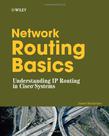网络路由基础
2006-4
John Wiley & Sons Inc
James Macfarlane
408
When James Macfarlane began teaching network routing, he simply could not find books that explained the subject clearly, understandably, and accurately. So he wrote his own. Authored by a consultant who has trained hundreds of networking professionals, this guide is designed to clear up the confusion and make the field of routing what Macfarlane believes it should be—understandable, interesting, and even fun. The goal of this book is to provide you with a working knowledge of routing technology and the confidence to use what you've learned. You'll take a major step toward passing an array of certification exams and be better prepared for the ultimate test—the real world. 作者简介: JAMES MACFARLANE is a 20-year veteran of the computer and networking industry. His career has covered consulting, network engineering, teaching, courseware development, and technical writing. He has held a long list of certifications, including Cisco CCNA, Microsoft MSCE and MCT, CompTIA A+ Trainer, Novell CNE and CNI. You can learn more at his Web site, www.HotTrainingMaterials.com.
AcknowledgmentsIntroductionChapter 1 Networking Overview Overview OSI Network Model The Conundrum of Explaining the OSI Model Mother of All OSI Model Explanations? Anatomy of a Data Communication Session The Way Things Used to Be Explanation of OSI Layers Another Mail Analogy Encapsulation TCP/IP Model Networking Equipment Packet Forwarding Repeaters—Layer 1, Physical Hubs—Layer 1, Physical Bridges—Layer 2, Data-Link Switches—Layer 2, Data-Link Routers—Layer 3, Network Layer 3 Switches CSU/DSUs (TSU) TCP/IP Review IP Addressing Ports and Sockets Important Protocols Related to Routing NotesChapter 2 Routing Basics Overview What Is Routing? Routing Begins at Home--The Workstation's Route Table Row 1—Default Gateway Row 2—Loopback Address Row 3—Local Subnet Address Row 4—IP Address of Host Rows 5, 6, and 7—Broadcast Information Anatomy of a Routed Packet Track a Packet—Source and Destination on the Same Network Track a Packet—Source and Destination on Different Networks—One Router Track a Packet—Source and Destination on Different Networks—Multiple Routers Anatomy of a Route Table Key Concept for Understanding Route Tables Populating Route Tables Routing Metrics Administrative Distance Summary NotesChapter 3 Static Routing Overview What Is Static Routing? When to Use Static Routes Configuring Static Routes on a Router Example with a Small Routed Network Static Routes on a Workstation Floating Static Routes Propagating Static Routes Summary NotesChapter 4 Dynamic Routing Overview The Need for an Automated Routing Solution What Is a Routing Protocol? Considerations for Designing Routing Protocols Metrics of Routing Protocols Categorizing Dynamic Routing Protocols Interior versus Exterior Routing Protocols Distance Vector versus Link-State Singlepath versus Multipath Broadcast versus Multicast ……Chapter 5: RIPChapter 6: IGRPChapter 7: EIGRP. Chapter 8: OSPF. Chapter 9: External Routing Protocols in Brief Chapter 10: Redistribution and Default RoutingAppendix A: Where Do You Go From Here? Appendix B: Recommended ReadingAppendix C: RFCs Related to Routing Appendix D: Web ReferencesAppendix E: Administrative Distance TableAppendix F: Quick-and-Dirty Subnetting—No Calculator Appendix G: Subnetting Helper SheetIndex
